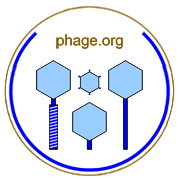

Holes in bacterial lawns produced by phage strains that are particularly effective at lysing indicator bacteria.
Phages that display a reduced efficiency of lysogenization often produce clearer plaques than their parental strains since turbidity-producing lysogen microcolonies do not form. Though these in particular are mutants of temperate phages, in fact certain mutants of filamentous phages are also known which produce clear plaques, though here this occurs not because of a lack of lysogen formation, which doesn’t occur regardless, but instead due to increased phage-mediated inhibition of bacterial growth.
Clear plaques associated with mutant temperate phages are formed on lawns consisting of either non-lysogens or heteroimmune lysogens, though a subset of such mutants are able to form clear plaques – indeed, are able to form plaque at all – on otherwise homoimmune lysogens. See virulent mutant as well as intemperate for additional discussion.
The turbidity of plaques formed by wild-type temperate phages are a consequence of microcolony formation by lysogens that grow over the course of plaque formation, that is, microcolonies that are initiated early on during plaque formation from bacteria in which lysogenic cycles have been initiated. Phages that are unable to form lysogens thus fail to produce these phage-resistant, i.e., phage-immune microcolonies, and as a consequence remain clear (typically meaning relatively free of intact bacteria).
From the glossary of Hershey (1971), p. 773, note this definition of "clear", as in, "clear" plaque: "Lambda and other temperate phages form plaques that are turbid owing to growth of cells surviving the infection. Mutants forming clear plaques (clear mutants) establish immunity less efficiently and permit fewer cells to survive."
From Ptashne (2004), p. 68: "Most of these clear mutants bear a lesion in one of three genes: cI, cII, or cIII. It is possible to isolate a rare lysogen of a cII or cIII mutant; once isolated the lysogen is stable, immune, and inducible by ultraviolet light. But it is never possible to isolate a lysogen of a cI mutant."
For more on this topic, see Wikipedia, Google, and PubMed. Contact web master. Return to terms.